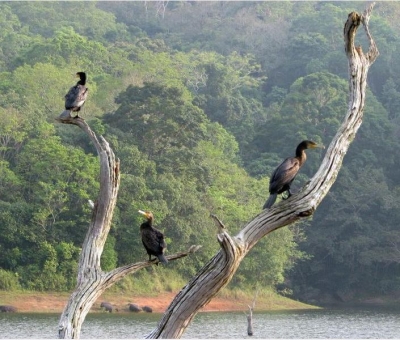
Spanning over 725 sq. km., the Periyar Tiger Reserve in Kerala is one of the rich biodiversity hotspots of the Western Ghats. Comprising a range of tropical evergreen and semi-evergreen forests, moist deciduous forests, grasslands and eucalyptus plantations, it is amply nourished by rivers such as the Periyar running through the region. The reserve is a green zone that’s home to more than a 100 varieties each of grasses and orchids – perfect to welcome several species of mammals, reptiles, amphibians, birds and butterflies. The region also hosts a large number of Asiatic elephants, making it one of the most significant elephant reserves of the country.
Wildlife
Garganeys, little grebes, nightjars, swift, coucal, malkohas, crakes, bitterns, cormorants, snipes, sandpipers, harriers, hornbills, woodpeckers, barbets, bee-eaters, falcons, minivets, orioles, woodshrikes, shrikes, treepies, flowerpeckers, sunbirds, leaf birds, munias, pipits, wagtails, tits, larks, prinias, warblers, swallows, babblers, starlings, nuthatches, flycatchers, robins and thrushes are among the species of birds that can be seen here. In addition to the Royal Bengal tiger and the Asiatic elephant, one can spot mammals such as leopard, bison, sambar, barking deer, Indian wild dog, wild boar, Nilgiri marten, Nilgiri langur and otter. A variety of reptiles such as cobra, viper, krait, and Indian monitor lizard, and amphibians such as frogs and toads too are found in the region.
Cause for concern
report by the Comptroller and Auditor General of India in 2019 A said that the Travancore Devaswom Board (TDB), an autonomous body that manages 1,248 temples including the Sabarimala Ayappa Temple, has been violating the Master Plan for Sabarimala for over a decade. This is affecting the ecology of the Periyar Tiger Reserve”. The report on the implementation of Wildlife Protection Act in Kerala says that the “impact of Sabarimala pilgrimage ranked first in the list of 18 major threats identified by Periyar Tiger Reserve authorities in Tiger Conservation Plan”. It added that due to the lack of drainage facilities, overflowing waste water and sewage was mixing with the rivers in the region. Further, electric lines had not been laid underground, and the existing “overhead cables without insulation” could pose a threat to wildlife species in the area.
Poachers to protectors
The Periyar Tiger Reserve is an example of an unusual success story. According to Mongabay, a conservation and environment news and features service, the story begins towards the end of the 20th Century, when a forest brigand operating near the reserve is captured. He led a 23-member gang of poachers and sandalwood smugglers. And was willing to give it all up if they were assured of a job with a steady income. However, back then there was no provision to include poachers and smugglers in forest management. Several discussions happened and a few years passed before Vidiyal Vanapathukappu Sangam was set up. It would be the country’s first eco-development committee constituted solely of former poachers and sandalwood smugglers””. The group underwent training and was exposed to the need for conservation. It’s been 17 years since. The members have helped crack at least “230 cases of poaching and smuggling”. In addition to patrolling, they also double up as tourist guides and elephant safari providers. Most importantly, they have managed to educate their children – some are postgraduates today! The success of this model has been so encouraging that several other reserves and sanctuaries too have emulated it.
Picture Credit : Google

